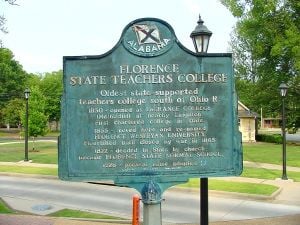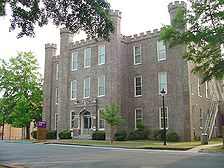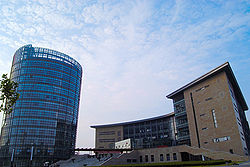Normal school

A teachers college, formerly known as normal school, is an institution dedicated to the training and professional development of teachers, most often found in Western post-secondary education systems, although most post-secondary education institutions in the world today have some form of specialized educational programs for the training of teachers. Originating in France during the 19th Century, many teachers colleges today have been amalgamated into universities and colleges to form Faculities, or Departments, of Education.
History
Before the 19th century, teachers were often scholars or clergymen who had no formal training in how to teach the subject they were experts in. The term "normal school" originated in the early 19th century from the French école normale. The French concept of an "école normale" was to provide a model school with model classrooms to teach model teaching practices to its student teachers.[1] The children, the teachers of the children, the student teachers, and the teachers of the students were all together in the same building. Although a laboratory school, it was the official school for the children—primary or secondary.
A normal school was a school created to train high school graduates to be teachers. Its purpose was to establish teaching standards or norms, hence its name. Most such schools are now called teachers colleges. However, in some places the term normal school is still used. In 1685, Saint John Baptist de La Salle, founder of the Institute of the Brothers of the Christian Schools, founded what is generally considered the first normal school, the École Normale,—that is, a school whose purpose is to train teachers—in Reims. In New Zealand, for example, normal schools are affiliated with teachers colleges. According to the Oxford English Dictionary, normal schools in the United States and Canada trained primary school teachers, while in Europe, normal schools educated primary, secondary and tertiary-level teachers.[2]
In the United States, the function of normal schools has been taken up by undergraduate and graduate schools of education; the schools themselves were upgraded to universities focused on meeting the needs of the region in which they were located. Many famous universities, such as the University of California, Los Angeles were founded as normal schools. In Canada, such institutions are typically part of a university as the Faculty of Education offering a one- or two-year Bachelor of Education program. It requires at least three (usually four) years of prior undergraduate studies.
Philosophy
Cultural Variants
In Europe
In France, a two-tier system developped since the Revolution : primary schools were educated at départemental écoles normales, high schools teachers at the Écoles normales supérieures. Nowadays all teachers are educated in instituts universitaires de formation des maîtres. The Écoles Normales Supérieures in France and the Scuola Normale Superiore di Pisa no longer specialize in teacher training.
In Finland, normal schools are under national university administration, whereas most schools are administered by the local municipality. A normal school is the official school of the children. Teacher aspirants do most of their compulsory trainee period in normal schools and teach while being supervised by a senior teacher.
In Asia
The terminology is still preserved in the official translations of such schools in both the Republic of China and the People's Republic of China since the early 20th century, East China Normal University being the first. A Chinese normal university (Chinese: 師範大學; pinyin: shīfàn dàxué, abbreviated 師大; shīdà) is usually controlled by the national or provincial government.
In Taiwan, the two national normal universities (one in Taipei and another in Kaohsiung) prepared secondary school teachers (although they have become de facto liberal arts universities in the late 20th century). There were also about ten Taiwanese provincial teachers colleges (Chinese: 師範學院; pinyin: shīfàn xuéyuàn, abbreviated 師院; shīyuàn, literally "normal colleges") that originated as normal schools established by the Japanese. After the Chinese took over the island, they were renamed provincial normal schools before becoming provincial teachers colleges. In the early 1990s, these teachers colleges came under national control and by the mid-2000s were all renamed "universities of education" (教育大學) or simply "universities" to signify their comprehensive training.
In the United States

The first normal school in the United States was founded in Concord, Vermont by Reverend Samuel Hall in 1823. Sixteen years later the first state funded normal school was founded in Lexington Massachusetts, thanks largely to the efforts of education reformers such as Horace Mann and James G. Carter[3]. In 1823, a school known simply as The Columbian School, the first of its kind in the United States, opened in Concord, Vermont; Influenced by similar academies in Prussia and elsewhere in Europe, they were intended to improve the quality of the burgeoning common school system by producing more qualified teachers.
The first normal school west of the Appalachian Mountains in the United States was the Michigan State Normal School, now Eastern Michigan University. It was created by legislative action in 1849 and opened in Ypsilanti, Michigan in 1853.[4] Harris-Stowe State University, now a state university in Missouri, was founded by the St. Louis public school system in 1857 and claims to be the oldest normal school west of the Mississippi River. The first state-authorized normal college to open west of the Mississippi River was Winona State Normal School, now called Winona State University. Opening in 1858, its creation was one of the first acts of the newly-formed Minnesota Legislature.
The State of Illinois passed an act to establish a normal school on 18 February 1857, and proposals were submitted to locate the new school in Batavia, Bloomington, Peoria, and Washington (in Tazewell County). Bids were opened by the State Board of Education in Peoria on 7 May 1857 and the offer from Bloomington, Illinois, was accepted. The normal school was located near the village of North Bloomington, which later was renamed Normal in honor of the school. The school, originally known as Illinois State Normal University (ISNU), is now known as Illinois State University.
The first normal school in what is now considered the Southwest was opened in 1879 as Sam Houston Normal Institute (now Sam Houston State University). Finally, the first state-run normal school on the West Coast was the Minns Evening Normal School, created in 1857 to train teachers for San Francisco's schools. It was taken over by the State of California in 1862 and became the California State Normal School (now San Jose State University).
The Lowry Normal School Bill of 1910 authorized two new normal schools in Ohio—one in the northwestern, another in the northeastern parts of the state. The Lowry bill was the last of numerous measures that had been proposed and defeated over several years to meet the urgent need for professionally trained elementary teachers in the northern half of the state. Ohio was one of the last states to provide professional training for its elementary teachers. Not until 1902 did the state’s oldest schools—Ohio University and Miami University—get colleges of education. The Ohio State University (OSU) had to wait until 1907. This predisposed all three, but especially so OSU, to treat any new schools as rivals. Moreover, those institutions were sprinkled across the mostly rural and small-town southern half of the state, where the fulcrum of political power had shifted after the death, in 1904,of Cleveland’s political boss Mark Hanna. Yet the greatest need for trained teachers was in the school systems popping up in the increasingly urbanized and industrialized northern half, which was also the most populous and prosperous. Political conflicts springing from sectional rivalry and competition for state funds, favor, and preeminence would shape much of the history of the Kent School.[citation needed] One of the oldest normal schools in Ohio was National Normal University in Lebanon, Ohio which opened in 1855.
In Latin America
Early normal schools in Latin America include several in Mexico, such as the Escuela Normal de Enseñanza Mutua de Oaxaca (1824), the Escuela Normal Mixta de San Luis Potosí (1849), the Normal de Guadalajara (1881), and the Escuela Normal para Profesores de Instrucción Primaria (1887). The Mexican normal school system was nationalized and reorganized by the Secretaría de Educación Pública (Secretariat of Public Education) under José Vasconcelos in 1921.
Perhaps the oldest continually operating normal school in Latin America is the Escuela Normal Superior José Abelardo Núñez, founded in Santiago, Chile, in 1842 as the Escuela de Preceptores de Santiago under the direction of the emininent Argentine educator, writer, and politician Domingo Faustino Sarmiento. The first normal school in the Dominican Republic was founded in 1875 by Puerto Rican educator and activist Eugenio María de Hostos.
On 1938 the Escuela Normal Juan Demóstenes Arosemena was founded in Santiago de Veraguas, Panama.
In Colombia, normal schools were primarily associated with women's religious schools although in modern times have admitted men, thus forming escuelas normales mixtas (mixed normal schools).
Notes
- ↑ école normale. Retrieved 2007-12-11.
- ↑ Oxford English Dictionary. Retrieved 2007-12-11.
- ↑ Normal Schools - History of American Education Web Project, Retrieved on 2007-03-08.
- ↑ Eastern Michigan University. A Brief History of EMU (HTML). Retrieved 2007-12-18.
ReferencesISBN links support NWE through referral fees
External links
- Normal school. (n.d.). he American Heritage Dictionary of the English Language, Fourth Edition. Retrieved December 11, 2007
Retrieved December 11, 2007
Credits
New World Encyclopedia writers and editors rewrote and completed the Wikipedia article in accordance with New World Encyclopedia standards. This article abides by terms of the Creative Commons CC-by-sa 3.0 License (CC-by-sa), which may be used and disseminated with proper attribution. Credit is due under the terms of this license that can reference both the New World Encyclopedia contributors and the selfless volunteer contributors of the Wikimedia Foundation. To cite this article click here for a list of acceptable citing formats.The history of earlier contributions by wikipedians is accessible to researchers here:
The history of this article since it was imported to New World Encyclopedia:
Note: Some restrictions may apply to use of individual images which are separately licensed.
